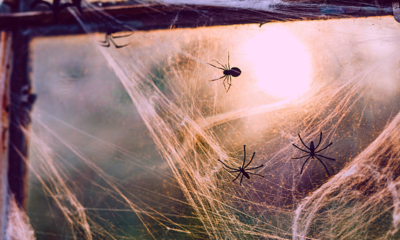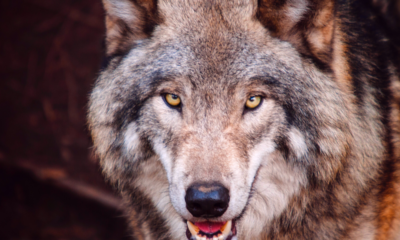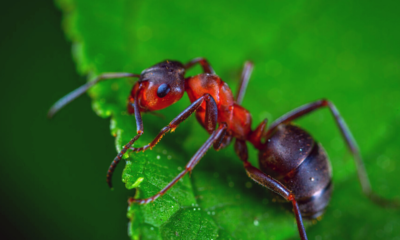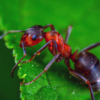
Animals
11 Biggest Bats In The World
For years and years, bats have been considered sinister and spooky, most probably because of their razor-sharp wings and beady eyes. However, there is much more to these bats than meets the eye.
There are over 1,300 species of bats found all over the world and this makes them the second most common group of mammals. While some bats are as tiny as a penny, others possess a wingspan of over six feet but whatever their size be, they are all impressive and play a vital role in our ecosystem.
The scientific name for bats is Chiroptera, which means hand wing. This is because the bats have four long fingers and a thumb, which is connected by a thin layer of skin.
It comes as a surprise that bats are the only mammals on earth that can fly and are apparently very good at it. Since they have flexible skin and movable joints, they can change direction easily and even catch mosquitoes in air.
Did You Know?
Bat droppings apparently play a very important role in people’s lives. Their droppings, also known as guano, are very rich in potassium nitrate and are used as a fertiliser. This potassium nitrate is also extracted sometimes for use in gunpowder and explosives. Infact, bat droppings played a vital role during the American Civil War. Bat guano is also used to preserve fossils!
Here are some of the biggest bats in the world:
11. Horseshoe Bat
Scientific Name: Rhinolophidae
Weight: 0.01 pounds
Location: Asia, Africa
Coloration: Reddish, chestnut-brown
Conservation Status: Least concern
Horseshoe bat, any of more than 100 species of large-eared insect-eating bats that make up the sole genus of the family Rhinolophidae. Their taxonomic name refers to the large complex nose leaf consisting of a fleshy structure on the muzzle. Of the three leaf sections, one resembles a horseshoe—hence their common name.
Formerly a cave-dweller, the horseshoe bat now tends to roost in old houses, churches and barns. All UK bats are nocturnal, feeding on midges, moths and other flying insects that they find in the dark by using echolocation.
In early summer, greater horseshoe bats will emerge at dusk and dawn, however, preferring to roost through the middle of the night. From May, females form maternity colonies to have their pups. Greater horseshoe bats hibernate over the winter in caves, disused mines, tunnels and cellars.
Did You Know?
Greater horseshoe bat often choose a regular perch in a tree or cave from which they can watch for passing insects; when they spot their prey, they fly out to catch it in the air. Insect remains beneath such perches can be spotted in spring and autumn, in particular.
10. Long-tongued fruit bat
Scientific Name: Macroglossus sobrinus
Weight: 0.05 pounds
Location: Southeast Asia
Coloration: Light reddish-brown
Conservation Status: Least concern
(Macroglossus sobrinus, also known by the common name the long-tongued fruit bat, is amongst the smallest of the megabats. This long-tongued fruit bat is nectarivorous, feeding on nectar from primarily banana flowers. It is found in several countries in South and Southeast Asia.
The body length of these bats, including the head is approximately 60 – 85 mm long. The tail is extremely short, reaching to only about 4 mm at the longest length.
Greater long-tongued fruit bats typically forage alone, with pairs found rarely. Individuals tend to roost alone, although small groups are also found. In Malaysia, these groups ranged from 5 to 10 individuals, most commonly found in palm trees, roofs, and banana plants.
These long-tongued fruit bats do not use echolocation as a means of communication. Instead, they emit audible calls of less than 9 kHz with a duration of about 15 milliseconds and inter-call intervals around 128 milliseconds.
Did You Know?
In stressful disturbance situations, these bats emit harsh broadband signals as distress calls. The call is a large series of clicks with duration greater than 100 milliseconds.
9. Wahlberg’s epauletted fruit bat
Scientific Name: Epomophorus wahlbergi
Weight: 0.26 pounds
Location: Africa
Coloration: Greyish brown, russet, or tawny
Conservation Status: Least concern
The Walberg’s epauletted fruit bat can be found in Africa, anywhere south of the Sahara desert. These bats live in woodland and savannah areas, and prefer the edges of forests. During the summer, they migrate in large numbers to Taaween, in the Zoutpansberg district of South Africa, attracted by the ripening crop of guavas.
During the daylight hours these megabats roost in hollow trees underneath large leaves and beneath the eaves of buildings. They are easily distinguished by their face and head which resembles that of a dog.
While roosting, bats are usually quiet and do not intrude on each other’s space. They like to groom themselves and this may last up to 30 minutes; after that, they usually take off from the roost tree.
Most flight occurs in the first three hours of the night. The flight of Wahlberg’s epauletted fruit bat is relatively slow and somewhat clumsy, and they often bump into other individuals and obstacles.
Did You Know?
These bats are named for erectable epaulettes of hair that form around large scent glands in males only. Males are also distinguished from females by air sacs on the neck that may increase the volume of courtship calls. Scent glands are located near the white ear patches in both sexes.
8. Fijian monkey-faced bat
Scientific Name: Mirimiri acrodonta
Weight: 0.56 pounds
Location: Fiji
Coloration: Dull olive green to yellow
Conservation Status: Critically Endangered
Also known as Fiji flying fox, the Fijian monkey-faced bat is the only member of its genus and the only mammal endemic to the Republic of Fiji. One of the larger megabats in the region, this orange-eyed bat is covered in fairly thick hair and weighs up to 350 grams. It was recognized as its own genus in 2005.
The fact that this species is an island endemic, with a very restricted range (one of the most restricted distributions of all bats) increases its risk of extinction in the wild. The Fijian Flying Fox habitat, the montane cloud forest, has a limited distribution in Fiji, and is also of global conservation concern because of its vulnerability to climate change and slow recovery after hurricanes.
Did You Know?
The Fijian flying fox is the smallest of the three fruit bats found in Fiji. Until 2009, no ecological research had been undertaken on this flying fox and nothing was known about it other than its nocturnal habits and its apparent restriction to montane cloud forest over 900m.
7. Lyle’s flying fox
Scientific Name: Pteropus lylei
Weight: 0.68 pounds
Location: Southern Asia
Coloration: Dark brown or yellowish-brown
Conservation Status: Vulnerable
Lyle’s Flying Fox occurs in the central plains of Thailand, including towns around the capital Bangkok, and parts of Vietnam and Cambodia.
Lyle’s Flying Fox is a species of limited distribution, which roosts by day in large colonies in protected areas of villages, towns and cities, such as the leafy compounds of Buddhist temples and other buildings where they can be free of persecution.
At sunset they radiate out into rural areas to feed on fruits and, as a consequence, they may be killed by farmers and landowners when they raid fruit orchards.
The species can be distinguished from other flying foxes on the basis of size and fur colour. The wing membranes are dark brown and the lower back has short, brownish-grey fur. Fur on the upper back, chest and throat is orange and fluffy. The head is dark brown, and fur on the underside is generally darker, sometimes black.
Did You Know?
The largest known colony of the Lyle’s Flying Fox is in Thailand, which comprises as many as 3000 specimens.
6. Straw-coloured fruit bat
Scientific Name: Eidolon helvum
Weight: 0.75 pounds
Location: Africa, Asia
Coloration: Yellowish brown
Conservation Status: Near Threatened
The African Straw-coloured Fruit Bat is the second largest fruit bat in Africa. It can have a wingspan up to one metre and adults can weigh up to 350g. These bats are very strong fliers, with long, pointed wings built for endurance over agility. Because of this, they can’t manoeuvre in tight spaces and find their food in the more open upper canopy layer.
The straw-colored fruit bat gets its name from the yellowish or straw-colored fur around the neck. Part of neck and back can be yellowish-brown while their underside is tawny olive or brownish.
This species is nocturnal, roosting in tall trees during the day and flying at night in search of fruit. They roost in a very social group of from 100,000 to 1,000,000 individuals, leaving at night in small groups to find food in nearby forests or on plantations.
Did You Know?
Once a year they come together in their millions to Kasanka National Park, Zambia, in the world’s largest mammal migration. They are able to travel thousands of kilometres each year, and have the furthest recorded migration of any African mammal.
5. Mariana fruit bat
Scientific Name: Pteropus mariannus
Weight: 1.2 pound
Location: Mariana Islands and Ulithi
Coloration: Dark brown
Conservation Status: Endangered
Mariana fruit bats, also known as flying foxes or fanihi, are medium-sized bats with dark brown fur. Bats in the genus Pteropus are known as flying fox because their face and ears resembles a fox or small dog.
Most of the islands on which Marianas flying foxes are found are tropical or subtropical. Large colonies can be found roosting in stands of native forest, smaller groups are found in isolated patches of native forest or in coconut tree groves.
Marianas flying foxes are medium-sized bats, weighing 330 to 577 grams. Their forearms measure 34 to 54mm. Wingspans range from 860 to 1065 mm. Overall length, from snout to rump, is 195 to 240mm. Males are usually a little larger than females. Mariana flying foxes are handsome bats, with black to brown fur over most of their body, flecked with silver hairs.
These bats are sedentary and live in colonies. Males form harems or bachelor groups. Some males will also lead solitary lives at the edge of the colony. Although they are sedentary, these bats are strong flyers and are capable of traveling long distances.
Did You Know?
These bats serve as an important cultural food for the native people of the Marianna Islands, and they will often risk fine and imprisonment to have Marianna flying foxes!
4. Greater Flying Fox
Scientific Name: Pteropus giganteus
Weight: 1.3 pounds
Location: Southeast Asia
Coloration: Dull gray-brown
Conservation Status: Near Threatened
The Large flying fox is a species of megabat that belongs to the Old World fruit bats family. It is one of the largest species of bat. There are over 60 species of bat belonging to this genus and they are found on tropical islands from Madagascar to Australia, and Indonesia to mainland Asia.
They have long and woolly hair, which are shorter and more erect on the upper back. The color and texture of the coat differ between sexes and age classes. Males tend to have slightly stiffer and thicker coats than females. They are the largest bats; some attain a wingspan of 1.5 metres (5 feet), with a head and body length of about 40 cm (16 inches).
These intelligent animals live in large colonies that are made up of individuals and family groups. They establish permanent and semi-permanent camps in areas that are close to food sources. At dawn and dusk, these flying foxes can be heard making various calls to communicate as they leave to feed or as they return to sleep. As they are mostly nocturnal, they roost in trees during the day.
Did You Know?
Their digestive system is so rapid that they may begin to defecate within 30 to 60 minutes of eating. This can reduce the load that they need to carry during flight. These bats can consume between 25 and 35% of their body weight daily.
3. Sulawesi flying fox
Scientific Name: Acerodon celebensis
Weight: 1.5 pounds
Location: Indonesia
Coloration: Golden Brown
Conservation Status: Vulnerable
Bats make up approximately half of all the mammal species in Sulawesi. Even though the island is substantially smaller than Borneo, Sumatra, or New Guinea, it boasts a greater number of species of old-world fruit bats (Pteropodidae).
The Sulawesi flying fox or Sulawesi fruit bat is a species of megabat endemic to Indonesia. This bat has been classified as vulnerable by the IUCN due to unsustainable levels of hunting.
These bats are frugivore, feeding preferentially on coconuts and breadfruits. They usually roost in trees, often in mangrove forests, and is somewhat sensitive to human disturbance.
Did You Know?
Populations of this beautiful bat are declining primarily due to pressure from local hunting for home consumption and the bushmeat trade. Known roosting sites are heavily exploited, and the lack of official protection means that roosting trees may also be cut down.
2. Livingstone’s fruit bat
Scientific Name: Pteropus livingstonii
Weight: 1.75 pounds
Location: Anjouan and Mohéli islands
Coloration: Black with golden hair
Conservation Status: Critically endangered
The rare bat is found only on two small islands of Anjouan and Mohéli in the Comoros archipelago, off the southeast coast of Africa, where its population is down to about 1,200 individuals, researchers report in the study published in Oryx.
The bats fly using their long webbed fingers – their scientific name ‘Chiroptera’ is actually Greek for ‘hand-wing’. In the wild, during the day time they roost at the tops of tall trees, occasionally stirring to squabble with their neighbours. As evening approaches they become more active and by morning, they return to their roost trees, where they will spend much of the day hanging upside down from the branches.
As their name suggests, these bats eat fruit. In the wild, they leave their roost trees towards dusk and fly off in search of trees laden with ripe fruits, on which they gorge themselves.
The first Livingstone’s bats arrived at Durrell in 1992 – the species had never been kept in captivity before and bats had to be brought from the steep forested slopes that they call home. This was a difficult exercise and it took four expeditions to catch enough bats for a successful start to the captive breeding programme designed to safeguard the species from being wiped out.
Did You Know?
When Livingstone’s fruit bats go the toilet they hold on to a branch using their thumbs and turn themselves the right way up! They also like to use their urine to wash themselves.
1. Giant Golden-Crowned Flying Fox
Scientific Name: Acerodon jubatus
Weight: 3.1 pounds
Location: Philippines
Coloration: Reddish-brown and golden
Conservation Status: Endangered
The Giant Golden-Crowned Flying Fox is the planet’s largest bat species, with a wingspan up to 5 feet 6 inches long and a weight of up to 3.1 pounds. The genus to which it belongs, Acerodon, includes four other megabat species found in Southeast Asia.
The golden-crowned flying fox, however, is the only one of this genus whose range encompasses a large part of the Philippines. The eating habits of this flying frugivore play an essential role in the multiple forest ecosystems in which it lives.
As it eats fruits, primarily figs, it distributes their seeds all over the forest, contributing to reforestation in the Philippines. While the golden-crowned flying fox is one of the largest bat species in the world, it can be incredibly hard to find, as habitat destruction and hunting have caused huge declines in this species’ numbers in the past and continue to threaten its survival.
Did You Know?
Local communities hunt bats for sale, sport and personal consumption. In addition, more than 90 percent of the Philippines’ old-growth forests have been destroyed, and the species has completely disappeared from several of its old roosting sites on multiple islands.
Trisha Katyayan is an experienced journalist who has print-media background and loves to research, organize and curate factual information in a presentable way.
















